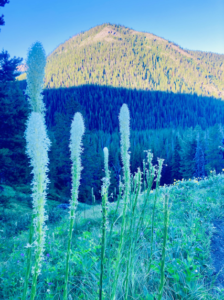 Thimbleberry, lodgepole, lupine, wild roses, oregon grapes, wild strawberries, beargrass, arrowleaf balsamroot; these are the flowers and shrubs that I recognized as we made our way up rocky slopes into the Bob Marshall Wilderness–an area I’ve called my backyard since I was eight years old, when my parents moved my family to the small town of Seeley Lake, Montana. It wasn’t until I began this six-week semester course with the Wild Rockies Field Institute, however, that I took the time to get to know these plants on a personal level.
Thimbleberry, lodgepole, lupine, wild roses, oregon grapes, wild strawberries, beargrass, arrowleaf balsamroot; these are the flowers and shrubs that I recognized as we made our way up rocky slopes into the Bob Marshall Wilderness–an area I’ve called my backyard since I was eight years old, when my parents moved my family to the small town of Seeley Lake, Montana. It wasn’t until I began this six-week semester course with the Wild Rockies Field Institute, however, that I took the time to get to know these plants on a personal level.
My favorite part of Montana summers has always been the wildflowers. My mom boasts her skills as a ~master naturalist~ when we see the first lupine and balsamroots dotting the hills around Salmon Lake, the unpicked shooting stars and glacier lilies that pop up in our yard. Even more exciting is when we find huckleberries in town around the lake, and she puts me to work picking them along [_____] (if I told you she would kill me). They would bring sweet memories of summer warmth as they unfroze in our pancakes during winter.
During Section 1 of this course, on a sunny day in the Snowcrest Mountains southeast of Dillon, my seven peers and I each conducted a “plant study.” Everyone chose a different plant that we didn’t recognize and took about two hours to get to know it: observing its abundance, soil and slope preference, neighboring plants, and other defining characteristics. As I got to know what I named “Ant’s Alpine Picnic” (more widely known as alpine sorrel), I realized how little I know about the plants I grew up identifying, and the complex communities they are a part of. My knowledge of the plants I hold so dear stops at their common names and edibility. Over the course of this trip, from the flowers to the rivers and trees and bears, I’ve seen deeper connections in this ecosystem than I’d ever noticed before.
The focus of this course is “conservation across boundaries,” and throughout our various class discussions, readings, and meetings with guest speakers, the boundaries that have stood out to me as some of the most important to cross are those concerning education and accessibility. Not only are there physical barriers preventing people from accessing natural spaces, but there are social boundaries around educating people on such spaces; their importance and what the impact of humans and a changing climate mean for ecological communities. I thought of my connection to wildflowers because their obvious beauty and abundance across the globe provides a way for so many people to engage with the natural world in an appreciative way. Although this engagement is awesome, Ethan Linck points out that appreciative (or consumptive) use of a natural space is not in itself a conservation act. Since education on and access to wild spaces are such real boundaries to preserving biodiversity, the connection to nature needs to be based on more than beauty, or what humans determine as “useful.”
Including humans in our definition of an ecosystem changes the way we interact with nature, forcing us to think about how our uses of land impact us both in the long run. Sometimes our goals don’t always line up. When bison graze, controlling the vegetation in a way that benefits them and the soil, there are no fields of wildflowers to marvel at. However, that might make us more appreciative of the flowers that we do see, in the ecosystems they thrive in. Knowing the benefits of bison grazing patterns on grassland ecosystems also reveals another marvel.
As we started our 9.5 mile trek out of the Bob, chasing the sun as it rose over Route Creek Pass, I gawked at the meadows of green speckled with the yellow, blue, red, white, and pink I know as home. I took special notice to how the red paintbrush positioned itself close to other plants to steal their nutrients; it’s partially parasitic, similar to other vegetation whose red leafless stems lack the ability to photosynthesize. Their bright colors have always brought me joy, ignorant of how they were affecting their native neighbors. Leaving the Bob, aware of how unaware I was of the connections that were forming and breaking under the ground we walked on, under the cover of the trees filling the valley we were quickly leaving behind, I felt full of excitement. Of returning and continuing to get to know this beautiful, wild place, and sharing my knowledge that there’s so much more to the places we call nature, and the places we call home.